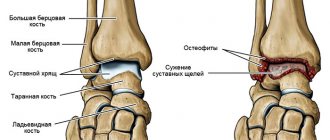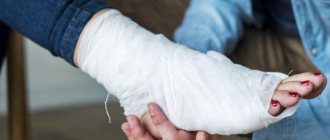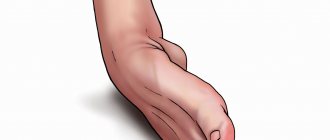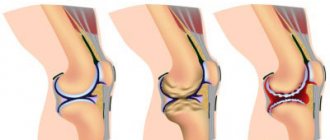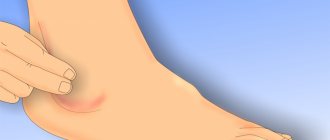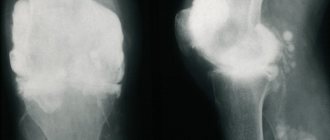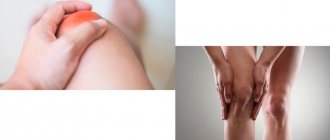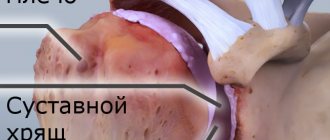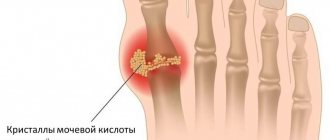Arthritis of the ankle
is an acute or chronic inflammatory process in the ankle area, which leads to metabolic disorders in the joint structures. This condition is accompanied by pain and stiffness when moving. But its main danger is that if left untreated, the disease causes degradation of cartilage and even bone tissue and spreads to ligaments, tendons and muscles. In advanced cases, ankle arthritis leads to disability and loss of ability to work.
Arthritis of the ankle joints is debilitating with constant pain and can lead to complete disability.
Since the ankle joint is one of the most loaded joints in the human body,
when it is damaged, a person instinctively transfers his body weight to the other leg. This starts a “domino effect” - soon other joints of the lower extremities and spine begin to fail. Can this condition be prevented and how can ankle arthritis be treated if it has already been diagnosed?
Causes of ankle arthritis
A number of reasons can provoke inflammation and destruction of cartilage tissue, from injury to infection that has entered the synovial bursa. Therefore, from the point of view of etiology, the disease is usually divided into primary (associated with direct damage to the joint) or secondary (associated with extra-articular disease) arthritis of the ankle.
There are 4 groups of causes of ankle arthritis:
- inflammatory (septic, tuberculosis, ankylosing spondylitis), dystrophic (deforming osteoarthritis, metabolic and endocrine diseases, pathologies associated with working conditions),
- traumatic (closed injuries or prolonged and regular vibration exposure)
- others (related to intoxication, diseases of the cardiovascular, nervous and other systems).
Most often, ankle arthritis occurs due to:
- metabolic disorders (diabetes mellitus, gout);
- autoimmune diseases (rheumatoid arthritis, systemic lupus erythematosus, psoriasis);
- degenerative-dystrophic pathologies (arthrosis of the knee, ankle, metatarsophalangeal joints);
- systemic infectious diseases (mycoplasmosis, chlamydia, influenza, dysentery, salmonellosis and other intestinal and respiratory infections);
- lower extremity injuries.
Factors that predispose to ankle arthritis also include:
- excess weight;
- advanced age;
- sedentary lifestyle;
- allergy;
- smoking;
- alcohol abuse;
- chronic stress;
- unbalanced diet;
- diseases of the spine associated with deterioration of the conduction of nerve impulses;
- increased professional or sports stress on the joint;
- unfavorable microclimatic or unsanitary living or working conditions.
If the disease has not progressed far, the signs of ankle arthritis may completely go away when the negative impact is eliminated - for example, losing weight, giving up bad habits, normalizing your diet and diet.
Otherwise, under the influence of the factors mentioned above, massive cell death occurs throughout the body. Due to the fact that metabolism in the joints is slow due to the lack of blood vessels in the cartilage, the breakdown products of dead cells do not have time to be eliminated. This leads to the accumulation of enzymes in the joints, which “eat away” the cartilage lining. This is why ankle arthritis should not be left to chance - even a short exacerbation is fraught with irreversible consequences!
What is post-traumatic arthritis?
Arthritis
– this is a group of diseases involving damage to the joint of a degenerative-dystrophic type. Pathology can be an independent disease or a symptom of another.
Post-traumatic arthritis
– a type of arthritis that involves the development of degenerative-dystrophic processes against the background of a previous injury, in a situation where dysfunction of the damaged part of the body is observed.
Athletes and elderly people are considered to be particularly susceptible to the disease.
In the absence of timely diagnosis and necessary treatment, the pathology leads to irreversible disability of the patient.
Ankle arthritis: symptoms of the disease
It is easy to confuse the signs of ankle arthritis with other musculoskeletal conditions that cause ankle pain (such as Achilles tendonitis). symptoms of ankle arthritis should be the reason to consult a doctor
- pain when moving the joint, lightly pressing or even touching the skin above the ankle (skin hypersensitivity);
- rapid fatigue of the legs;
- crunching when moving in a joint;
- erythema (redness on the skin due to the fact that the tissues are filled with blood);
- swelling of the joint and feet caused by synovitis;
- local increase in temperature and redness of the skin over the sore joint;
- stiffness when moving;
- frequent spasms and cramps in the lower leg and foot;
- in the later stages - noticeable curvature of the leg or the formation of bumps.
The main distinguishing symptom of ankle arthritis is sharp or aching pain,
which does not leave the patient during rest. Many patients complain of increased pain after the leg has been immobilized for a long time (for example, after a night's sleep). In the morning, as a rule, swelling and other symptoms of the disease increase - with ankle arthritis, patients need an average of 40-60 minutes of movement to restore ankle mobility.
Symptoms of ankle arthritis can easily be confused with other diseases, so consult your doctor for the most accurate diagnosis.
Quite often, arthritis of the ankle joint comes “like a bolt from the blue” - a person goes to bed healthy, and the next morning the leg is already swollen and painful. This is especially true for the infectious form of arthritis. Inflammation in the joint associated with metabolic and autoimmune diseases may coincide in time with exacerbations of the underlying disease.
Systemic manifestations are also characteristic of arthritis of the ankle joint - body temperature rises, weakness, fever with chills, increased sweating, lethargy, loss of appetite, and loss of body weight appear.
If 3 or more signs of ankle arthritis mentioned above appear, a diagnostic examination by an orthopedist or rheumatologist is required. During the interview, the doctor determines the presence of trauma, allergies, metabolic pathologies in the anamnesis, and clarifies the patient’s type of activity. The range of motion in the joint is checked. Laboratory tests are required for differential diagnosis - as a rule, analyzes of ESR and leukocytes, uric acid and rheumatic factor are needed. If there are clear symptoms of ankle arthritis, the specialist may limit itself to radiography.
Diagnosis of post-traumatic arthritis
If you have symptoms of post-traumatic arthritis, it is best to seek a diagnosis of the pathology from a traumatologist or rheumatologist. It is permissible to visit a therapist who will refer the patient to a specialist for accurate diagnosis.
Key techniques
clarifications of the diagnosis are:
Stages of ankle arthritis
With ankle arthritis, mobility in the joint is impaired, stagnation of synovial fluid begins, starvation and destruction of cartilage tissue. The degree of development of pathological changes and signs of arthritis of the ankle joint allows doctors to distinguish three stages of the disease.
Stage 1 arthritis of the ankle joint
Acute arthritis begins suddenly, with redness, severe swelling and sharp pain. Among the first symptoms of chronic ankle arthritis is mild pain when moving, which patients attribute to fatigue after a day of work. Over time, the discomfort does not go away, but only increases.
Although in the chronic course of the disease patients rarely seek help at this stage, it is at this stage that treatment of ankle arthritis gives the best results.
Stage 2 ankle arthritis
Pain syndrome annoys the patient almost constantly. Sometimes the pain is paroxysmal, sometimes subsiding, sometimes increasing, but never goes away completely. Sleep disturbances appear. The ankles become hot and swell (especially noticeable when the patient tries to put on shoes). Symptoms of ankle arthritis also appear on the skin - redness, hotness, and acute sensitivity. Limited mobility (inability to turn the foot), weather sensitivity and spasms force most patients to consult a doctor to find out how to treat ankle arthritis.
Stage 3: ankle arthritis
The position of the foot becomes noticeably deformed. Movement in the joint is almost completely limited, even with treatment for ankle arthritis. The patient has difficulty walking and needs assistive devices (cane, crutches, walker). Disability sets in.
Degrees of post-traumatic arthritis
Like any other type of arthritis, the pathology has several degrees of development:
1st degree
– slight stiffness of movement, discomfort of the affected part of the body;
2nd degree
– narrowing of the joint space, formation of bone growths (osteophytes);
3rd degree
– proliferation of multiple osteophytes, complete absence of joint space.
Each degree of development of post-traumatic arthritis is characterized by a certain symptomatic picture, which makes it possible to accurately diagnose the degree of progression of the pathology and formulate the most effective plan for complex treatment of the patient.
How to treat ankle arthritis
Treatment of ankle arthritis is carried out step by step and comprehensively, taking into account the stage and individual dynamics of the disease. First of all, patients are selected with medications and vitamin supplements, and physiotherapy is prescribed to relieve inflammation, relieve pain and improve metabolic processes. At the same time, diet therapy is used (especially effective for gouty arthritis) and a complex of exercise therapy for arthritis of the ankle joint. After acute symptoms are relieved and remission occurs, the patient is placed under the care of a rehabilitation physician, who prescribes massage, manual therapy, and wearing support orthoses and bandages.
In advanced cases, when conservative treatment of ankle arthritis does not bring results, surgical procedures may be required - endoprosthetics, arthroplasty and other reconstructive operations.
All measures for treating ankle arthritis are mutually reinforcing and should not be used individually.
Physiotherapeutic treatment of ankle arthritis
Physiotherapeutic treatment of arthritis of the ankle joints (usually carried out in sessions - from 8 to 24) is included in therapy when the inflammation subsides. It helps eliminate residual congestion, improve mobility in the joint, ensure lasting remission and quickly return the patient to normal life without symptoms of ankle arthritis.
Physiotherapy is one of the effective ways to combat pain associated with ankle arthritis.
A number of procedures (magnetic therapy, medicinal electrophoresis) are allowed at the peak of the disease. They enhance the effect of systemic and local drugs.
For the treatment of ankle arthritis, the following is used:
- laser therapy;
- ultra-high frequency therapy (UHF);
- amplipulse;
- phonophoresis with hydrocortisone ointment;
- UV therapy;
- massotherapy;
- cryotherapy;
- diadynamic therapy;
- balneotherapy and mud therapy.
Any independent warming of a sore joint in the acute stage is strictly prohibited!
Massage in the treatment of ankle arthritis
Massage for ankle arthritis helps restore nutrition to cartilage tissue, support muscles and ligaments weakened during the disease, eliminate stiffness and prolong remission even in chronic cases. The procedure is performed on both legs, involving the thighs, shins, ankles, and arches of the feet.
Please note: massage techniques are used strictly after the removal of “acute” symptoms. Massage in the presence of even slight residual inflammation can cause arthritis to recur.
Self-massage without the knowledge of a specialist for arthritis of the ankle joint is extremely undesirable.
Exercise therapy for ankle arthritis
Exercises for ankle arthritis should begin 2-4 weeks later, i.e., after the acute period of the disease has passed. If an exercise causes severe pain, you should postpone performing it until the ligaments are stronger. Particular care should be taken in case of traumatic arthritis of the ankle joint - exercises are contraindicated in the presence of fresh fractures, sprains and other injuries.
The course of exercise therapy for ankle arthritis is at least 2-3 months, if there is a risk of relapse - up to 2-3 years. It is important to perform a set of exercises for ankle arthritis every day (1 time), without skipping.
We recommend the following simple exercises for ankle arthritis, which are suitable for patients of any age and with any level of physical fitness:
- Starting position - sitting on a chair straight, hands holding the seat. Without lifting your heels from the floor, spread your feet as wide as possible to the sides and up, and then bring them together into a standing position.
- Starting position - sitting on a chair, feet on the floor approximately shoulder-width apart. Slowly and smoothly move your feet inward and upward until your big toes touch.
- Starting position - behind the chair, hands on the back. Rise up on your toes until you feel tension at the top point, without putting any emphasis on your hands (they hold on to the chair for safety).
- The starting position is the same. Focusing on your heel, lift your toes as high as you can, as if pulling them towards you.
- Starting position: standing, legs not wide apart. Gently rise up on your toes, bringing your heels together.
- The starting position is the same. Rise up on your toes, spreading your heels.
- Starting position - legs spread wide apart, the healthy leg is in front (toe forward), the painful leg is behind (toe slightly to the side). With your palms resting on the knee of your healthy leg, do a shallow squat on your healthy leg (the affected leg does not bend). The feet should be completely on the floor without lifting off. Repeat the same, placing the affected leg forward.
The following exercises for ankle arthritis can be performed in the morning while lying in bed - this will help you warm up and reduce pain when doing household chores.
- Starting position: lying on your back. Perform circular movements with your toes with maximum amplitude clockwise and counterclockwise.
- Starting position: lying on your back. Bring your toes in and out with maximum amplitude, swinging them left and right.
- The starting position is the same. Stretch the toe of your left foot forward, away from you. Right - back to yourself. Smoothly change legs.
- The starting position is the same. Curl your toes, tensing your muscles, and bring your feet together. Then pull your toes toward you and spread your feet.
These exercises for ankle arthritis are performed 6-8 times. Avoid sudden movements.
Please note that in the early days, exercise for ankle arthritis may cause moderate pain, and the pain in the joint may even worsen. But after 2-4 weeks, the discomfort will completely disappear, and the range of movements will increase.
Forecasts and prevention of infectious arthritis
Considering the prognosis of the disease, it is worth noting that only one third of patients with arthritis of infectious origin at the end of treatment are faced with unpleasant residual effects, which are expressed by joint immobility.
The most dangerous types of the disease are septic arthritis, because despite fairly favorable prospects, the fatal outcome is 5-15%
.
The risk group for developing infectious arthritis includes people of different ages who have ailments such as:
- rheumatoid arthritis;
- osteoarthritis;
- bad habits;
- weakened immune system;
- obesity of varying degrees.
For the purpose of prevention, it is recommended to follow the basics of dietary nutrition, attend prescribed therapeutic events, promptly treat existing diseases and, of course, monitor the general health of the body.
Drug treatment for ankle arthritis
Treatment of ankle arthritis with medications is carried out in several directions:
- relieving inflammation;
- elimination of pain;
- restoration of the cartilage lining of the joint;
- removal of decay products from the joint and periarticular tissues;
- improvement of tissue nutrition (stimulation of blood circulation).
In case of secondary ankle disease, treatment of the underlying pathology is also necessary - for example, taking antibiotics, cytostatics, antihistamines and basic drugs for the treatment of rheumatoid arthritis. The drugs are taken orally, externally, or as intra-articular injections for ankle arthritis.
Drug treatment for arthritis can quickly relieve pain and partially restore the cartilage tissue of the joint.
Attention: conventional analgesics for the treatment of ankle arthritis are used no longer than 3 days before visiting a doctor, as they mask complications!
Possible complications of post-traumatic arthritis
Failure to consult a doctor in a timely manner, inaccurate diagnostic measures, as well as refusal or deviation from the prescribed treatment plan can cause the development of unwanted complications
, among which:
Anti-inflammatory drugs for ankle arthritis
Anti-inflammatory drugs for the treatment of ankle arthritis are steroidal (hormonal) and non-steroidal. First of all, non-steroidal drugs (NSAIDs) are used, which are designed to relieve the symptoms of ankle arthritis, but do not affect the condition of the cartilage tissue. These include: artradol, ibuprofen, diclofenac, ketoprofen, meloxicam, nimesulide, indomethacin, celecoxib, lornoxicam.
If NSAIDs fail to relieve pain, the doctor prescribes a short course of GCs (glucocorticoids) - most often in the form of injections for ankle arthritis. You should take the course no more than 2 times a year, strictly following the doctor’s recommendations, since uncontrolled use of GCs negatively affects the immune system, the endocrine system, and can worsen the condition of the joints.
Most often used in the treatment of ankle arthritis: hydrocortisone, prednisolone, methylprednisolone, diprospan.
Chondroprotectors for ankle arthritis
Drug treatment of ankle arthritis with NSAIDs and GCs is symptomatic. But for joint regeneration, nutrients are needed - glucosamine and chondroitin, which are part of synovial cartilage and joint fluid. They provide sufficient viscosity of synovial lubrication, increase the elasticity and shock-absorbing characteristics of cartilage.
The most effective in the treatment of ankle arthritis are: artracam, artravir, chondroitin complex, dona, structum, protecon, arthra, alflutop, movex active, teraflex.
Antispasmodics and muscle relaxants for ankle arthritis
With arthritis of the ankle joint, disturbances in muscle tone and spasms are common, which disrupt metabolic processes and provoke an exacerbation of pain.
To eliminate them, use: drotaverine, tolperisone, tizanidine, mydocalm, baclosan.
Warming agents for ankle arthritis
Warming agents in the treatment of ankle arthritis are represented by ointments, creams, gels, compresses and balms for external use. They have a local irritating effect, help relieve pain and inflammation, and improve tissue trophism.
In any pharmacy you can buy: diclofenac, voltaren, fastum gel, finalgon, nicoflex, viprosal B, capsaicin, indomethacin ointment.
Treatment
Treatment of arthritis is aimed at eliminating the cause of the disease and risk factors that contribute to the development of inflammation, relieving symptoms, improving metabolism in the affected joint, and preserving its function.
This can be achieved through the use of medications, physiotherapy, physical therapy and massage. In advanced cases, with purulent processes, dislocations and subluxations, surgical intervention may be required. If the joint is completely destroyed, it can be replaced with an artificial one - endoprosthetics.
Conservative therapy, depending on the form of arthritis, includes the use of tablets, ointments and injections of various groups of drugs:
- antibiotics for bacterial infections;
- non-steroidal anti-inflammatory drugs and hormones;
- chondroprotectors – agents that improve the quality of joint tissue;
- painkillers;
- vitamins, microelements and amino acids.
Author:
Pugonina Tatyana Alekseevna, Therapist
Features of nutrition during treatment and prevention of infectious arthritis
Therapeutic nutrition for arthritis of various types is aimed primarily at normalizing the immune response, as well as weakening inflammatory processes, in order to restore the range of motion of the affected joint.
Nutritional features depend on:
- stages of disease development;
- presence of concomitant diseases;
- severity of clinical manifestations.
Based on this, we can come to the conclusion that there is no single diet. However, there are a number of general principles for creating a diet, including:
- fractional meals;
- preference for certain types of culinary food processing (boiling/baking/steaming/stewing);
- food intake temperature – no more than 60°C;
- limiting salt and liquid intake;
- giving up bad habits;
- saturating the diet with vitamins.
